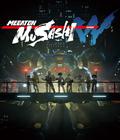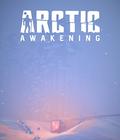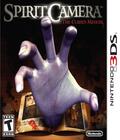Fatal Frame: Mask of the Lunar Eclipse is a sore spot for Western gamers. Developed by Grasshopper Manufacture and published by Nintendo, it was the latest game in a scary series that never made it out of Japan despite the previous three games being released worldwide. To this day, the only way for anyone outside of Japan to play this entry is to modify a console and apply a fan-made patch or buy a native Japanese console and learn enough of the language to get by. With no clear intentions to release this properly outside of Japan, Nintendo has released another related game from the series. Spirit Camera: The Cursed Memoir for the 3DS is a different take on the Fatal Frame franchise, and while the use of augmented reality is intriguing, the title isn't executed as well as it could have been.
Spirit Camera is split into three different modes, with the Story mode providing the heart of the experience. As the game's protagonist, you receive the cursed Diary of Faces, a 16-page booklet packaged with the game. Using your 3DS' outer cameras, you use it to look at the first page when you're transported into a haunted house. From there, you encounter Maya, an amnesiac who only remembers her name, as she stops you from going further into the house. You both escape into the real world, but it seems the inhabitants of the house have come along with you. Your job is to defeat the ghosts and solve the necessary puzzles to break the diary's curse.
The action is divided between two different activities. Puzzle-solving requires you to use the 3DS to view the Diary of Faces to trigger events and solve puzzles. Hints lead you to the appropriate pages to trigger events while some characters ask you to identify pages in the diary to solve puzzles. In between, there is combat, which should be familiar to fans of the Fatal Frame franchise. You have to find the spirit that requires you to physically turn until you get it in view. From there, you have to keep the spirit in view to power up the camera. Taking a photo of the spirit results in an attack, and the camera power and distance determine the amount of damage. Snapping pictures also acts as a defensive measure, as you're able to stop an attack if the timing is right.
The good news is that the combat is just as engaging as before. Keeping your focus on the enemy is exciting, especially since you're constantly moving to keep the target in range and power up your camera. Learning when to take a normal shot and when to take more powerful ones also factors into this; only close-up shots can interrupt a spirit's movements. Eventually, the game throws in tweaks to the combat system, such as lens changes and the ability to detect invisible spirits to get them out of hiding, but overall, it makes for some good gameplay opportunities. The same goes for some of the puzzles you'll encounter; they're not that difficult to solve but feel smart in their execution.
Unfortunately, the rest of the mode falls flat due to pacing and technical issues. The Story mode is quite short, only lasting about two hours, but much of that time is spent conversing with Maya. The conversations are more one-sided, as you simply hit the A button to help her get to the next sentence. It wouldn't be so bad if she had more interesting things to say or if she progressed the story at a faster pace. It also doesn't help that you usually have to locate her before you can initiate her dialogue, something that feels like it artificially lengthens the game even more. Considering you'll spend equal amounts of time playing and conversing, you'll start loathing her speeches.
The idea behind using the included book to initiate puzzles and story elements is good, but the technical issues quickly become frustrating. Because the system has no light source and can't read images well in dark environments, proper lighting must be used to play the game. Natural daylight is perfect while regular indoor lighting just won't do the trick. Even if you choose to augment your indoor lighting with a monitor or TV showing nothing but white light, it's out of the question to play in a darkened environment to create a frightening mood. Once you get the lighting right, getting the game to focus on the book images will vary per situation. Sometimes, the system immediately recognizes the image; other times, you'll have to fight to get the system to realize that you're looking at the correct thing from the correct distance. The technical frustrations are enough to make fickle gamers quit before the first chapter ends.
 The second mode, Haunted Visions, contains three different minigames that deal with faces. Spirit Photography has you take pictures that are later augmented with photos of different spirits. There are three lenses to choose from, including normal, 3-D, and one that reacts to faces. All of these photos can be saved into the system's SD card for later viewing. Spirit Check lets you take pictures of faces to later reveal different spirits and give you some background. Spirit Challenge acts the same as Spirit Check but has you fighting against the spirit you uncover. The last mode is Cursed Pages, a collection of minigames that revolve around the Diary of Faces. The minigames come from the Story mode, so if you've played through the story, you've already encountered all of them. The only difference is that each game now has variable difficulty levels.
The second mode, Haunted Visions, contains three different minigames that deal with faces. Spirit Photography has you take pictures that are later augmented with photos of different spirits. There are three lenses to choose from, including normal, 3-D, and one that reacts to faces. All of these photos can be saved into the system's SD card for later viewing. Spirit Check lets you take pictures of faces to later reveal different spirits and give you some background. Spirit Challenge acts the same as Spirit Check but has you fighting against the spirit you uncover. The last mode is Cursed Pages, a collection of minigames that revolve around the Diary of Faces. The minigames come from the Story mode, so if you've played through the story, you've already encountered all of them. The only difference is that each game now has variable difficulty levels.
These additions aren't that bad. All three of the activities in Haunted Visions are gimmicky, but since lighting doesn't affect the activities much, you'll find this to be least restricting tasks in the game. The Cursed Pages minigames have the same faults as Story mode in that proper lighting is the only way to get anything to work, but once you get the conditions right, the games are entertaining in the same way that the AR games built into the system were entertaining. If there were more of these games, the package might be a little more enticing.
Lighting issues aside, the graphics aren't that bad. The game world is appropriately dark but well detailed. The grimy and dilapidated look of the old house fits well when compared to the other locales of earlier games. The characters look appropriately creepy, especially the spirits, who are missing their faces, and their appearance in the real world isn't as jarring as expected. Though the 3DS' system cameras aren't the best, the other AR elements blend in rather well.
As for the 3-D effect, it works very subtly here. The game world has a nice level of separation between elements, and the real world does the same when differentiating between the spirits and the rest of the world. However, you'll be moving around so much that unless you can always stay focused on the upper screen, you'd be better off without the effect in play.
The sound works well most of the time. The music continues on the themes set by the original games. Moody but melodic, they fit perfectly with the frightening atmosphere the game tries to establish. The voices are only set to English, but the performances are quite good. From Maya to the woman in black to the other spirits that terrorize you, there isn't a voice that sounds grating or out of place. What is annoying is that voices aren't constant. While everyone always speaks to you when they're on-screen, Maya sometimes goes silent when she opens her mouth. There isn't a consistent pattern to when you do or don't hear her, so you can have long stretches where you hear everything she says — followed by a few sentences where she stays silent. The inconsistency in her audio pattern is puzzling, especially since the rest of the game has other elements taking up space in the cart.
The underlying idea behind Spirit Camera: The Cursed Memoir good, but the overall package isn't up to snuff. The main quest is too short and doesn't pack in the scares like you would expect, especially since you need to play this in a well-lit area. The amount of downtime experienced doesn't make the story better, and the constant fight for proper lighting and space for the most trivial things makes it a more restrictive experience. Even though the minigames try to pad out the experience, they aren't something you'll go back to very often. Even if you're starving for more augmented reality games, pass on this one and hope for something better.
Score: 5.5/10
More articles about Spirit Camera: The Cursed Memoir











 Spirit Camera: The Cursed Memoir is an immersive, horror-themed game that uses its built-in camera functions and augmented-reality features to enhance a sinister, spellbinding storyline, incorporating players own pictures and surroundings to create a personalized 3D horror experience.
Spirit Camera: The Cursed Memoir is an immersive, horror-themed game that uses its built-in camera functions and augmented-reality features to enhance a sinister, spellbinding storyline, incorporating players own pictures and surroundings to create a personalized 3D horror experience.


